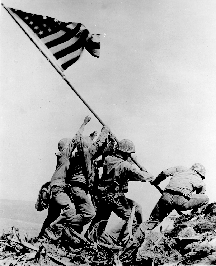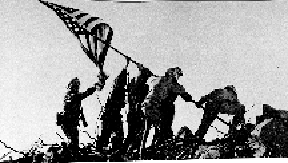Guidelines for Critical Film Viewing
|

|

|
photo of Iwo Jima flag raising
|
film re-enactment of the same event
|
Becoming a critical film viewer requires learning different skills than those of critical reading. Good films tend
to efface their own techniques and appear seamless and natural. Unlike a book, you can't go back and dissect this
structure. Therefore, critical film viewing requires seeing with two sets of eyes: one for watching the film, and
one that is careful to analyze what happens as you watch it. Below are some questions that will help you acquire
this skill.
- Who is responsible for the film?
What company, group, or individual produced and/or directed it? Who is the author
and what is the purpose of the message?
- What is their attitude towards their subjects? No film, not even a documentary, is neutral. Strive to become
aware of lighting choices, interview topics, editing, and voiceovers that move you emotionally in one direction
or the other. What techniques are used to attract your attention?
- For documentary films: What is the subject and what is implied about
the subject? Documentary films tend to present their subject matter in
a straightforward manner that implies that this film is the last word on the subject. However, even documentaries
have a point of view. Is there a difference between the stated and implied subject? For example, the film may document
Nazi atrocities, but the implied subject may concern Nazi indifference about such atrocities. In the film Das
Boot the subject is ostensibly about a German U-boat, but the implied subject is the horror of war for all
participants. This implied subject is nowhere stated directly. What lifestyles, values, and points of view are
represented?
- For films based on events: How have the filmmakers chosen to re-enact
the event? The filmmakers present the re-enactment
as though you were watching it happen. In reality, they have made choices that state a point of view about the
events. Try to discover their point of view. Who have they chosen to play the historical characters? Do their choices
make you sympathetic or hostile to the characters?
- What circumstances surround the event(s) that affect your feelings about
it? Try to discover one "extraneous" scene or group of scenes
that are not necessary to the story and figure out what the filmmakers included it/them. For example, in the film
The Wansee Conference, the intermittent cuts of a barking, playful dog become sinister when one discovers
that the dog has been used to discover hidden Jews in Eastern Europe. Why did the filmmakers choose to put in these
scenes?
- How might different people interpret the message differently? Often people have very different reactions to films; pay attention
to views different from your own. For example, different reactions to the film Night and Fog cause some
people view Holocaust victims sympathetically while others are repelled by their apparent passivity.
- What is omitted from the film?
In the same film, the word "Jew" is never mentioned. What
difference, if any, does this omission make?